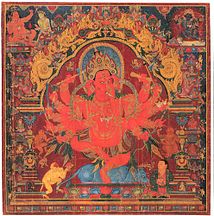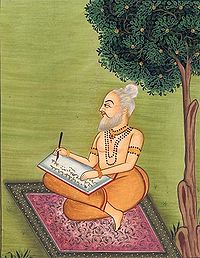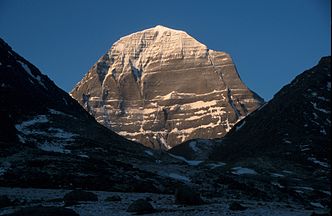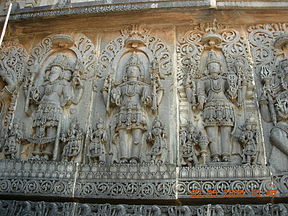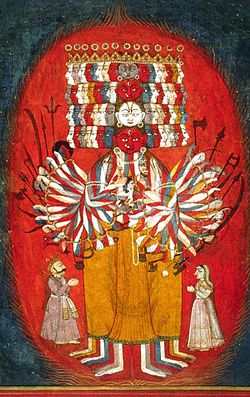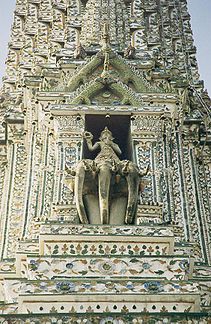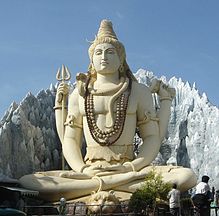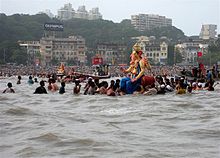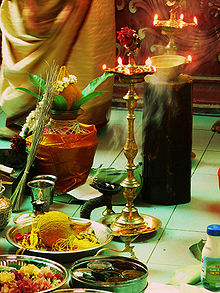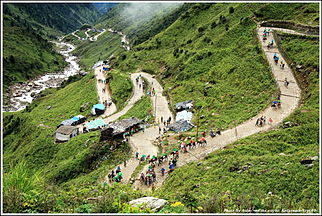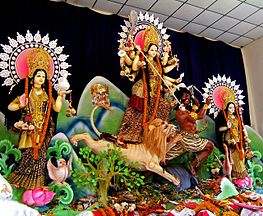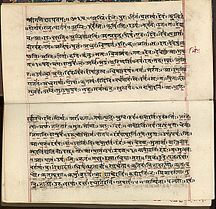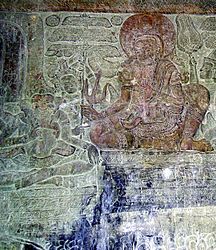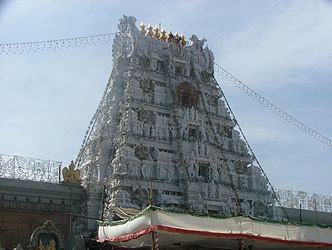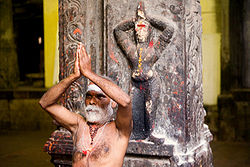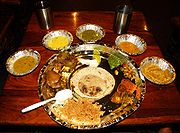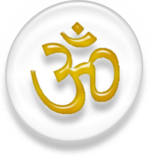- Hinduism
-
An article related to
HinduismPracticesHinduism is the predominant and indigenous religious tradition[3] of the Indian Subcontinent. Hinduism is known to its followers[4] as Sanātana Dharma (a Sanskrit phrase meaning "the eternal law", "the eternal law that sustains/upholds/surely preserves"[5][6]), amongst many other expressions.[7][8] Generic "types" of Hinduism that attempt to accommodate a variety of complex views span folk and Vedic Hinduism to bhakti tradition, as in Vaishnavism. Among other practices and philosophies, Hinduism includes a wide spectrum of laws and prescriptions of "daily morality" based on the notion of karma, dharma, and societal norms. Hinduism is a conglomeration of distinct intellectual or philosophical points of view, rather than a rigid common set of beliefs.[9]
Hinduism is formed of diverse traditions and has no single founder.[10] Among its direct roots is the historical Vedic religion of Iron Age India and, as such, Hinduism is often called the "oldest living religion"[11] or the "oldest living major religion" in the world.[12][13][14][15]
A large body of texts is classified as Hindu, divided into Śruti ("revealed") and Smriti ("remembered") texts. These texts discuss theology, philosophy and mythology, and provide information on the practice of dharma (religious living). Among these texts, the Vedas are the foremost in authority, importance and antiquity. Other major scriptures include the Upanishads, Purāṇas and the epics Mahābhārata and Rāmāyaṇa. The Bhagavad Gītā, a syncretistic treatise from the Mahābhārata, is of special importance. It combines Vedanta, Yoga, and some Samkhya philosophy into its discussion of good conduct and life.[16]
Contents
Etymology
The word Hindu is derived from the Sanskrit word Sindhu, the historic local appellation for the Indus River in the northwestern part of the Indian subcontinent.[17] and is first mentioned in the Rig Veda[18]
The word Hindu was first used by Arab invaders and then went further west by the Arabic term al-Hind referring to the land of the people who live across river Indus.[19] and the Persian term Hindū referring to all Indians. By the 13th century, Hindustān emerged as a popular alternative name of India, meaning the "land of Hindus".[20]
The term Hinduism also occurs sporadically in Sanskrit texts such as the later Rajataranginis of Kashmir (Hinduka, c. 1450), some 16th-18th century Bengali Gaudiya Vaishnava texts, including Chaitanya Charitamrita and Chaitanya Bhagavata, usually to contrast Hindus with Yavanas or Mlecchas.[21] It was only towards the end of the 18th century that the European merchants and colonists referred collectively to the followers of Indian religions as Hindus. The term Hinduism was introduced into the English language in the 19th century to denote the religious, philosophical, and cultural traditions native to India.
About Dharma
The concept of a "power" that is held to lie behind nature and that keeps everything in balance became a natural forerunner to the idea of Dharma. The idea of rta laid the cornerstone of dharma's implicit attribution to the "ultimate reality" of the surrounding universe, in classical Vedic Hinduism the following verse from the Rig-Veda is an example where rta is mentioned:
O Indra, lead us on the path of Rta, on the right path over all evils. -(RV 10.133.6)The transition of the rta to the modern idea of dharma occurs in the Brihadaranyaka Upanishad. The Upanishads saw dharma as the universal principle of law, order, harmony, all in all truth, that sprang first from Brahman. It acts as the regulatory moral principle of the Universe. It is sat (truth), a major tenet of Hinduism. This hearkens back to the conception of the Rig Veda that "Ekam Sat," (Truth Is One), of the idea that Brahman is "Sacchidananda" (Truth-Consciousness-Bliss). Dharma is not just law, or harmony, it is pure Reality. In the Brihadaranyaka's own words:
Verily, that which is Dharma is truth, Therefore they say of a man who speaks truth, "He speaks the Dharma,"
or of a man who speaks the Dharma, "He speaks the Truth.", Verily, both these things are the same.In the Mahabharata, Krishna defines dharma as,
"Dhāranād dharma ityāhur dharmena vidhrtāh prajāh, Yat syād dhārana sanyuktam sa dharma iti nishchayah"i.e., Dharma upholds both this-worldly and other-worldly affairs. (Mbh 12.110.11).
The word Sanātana means 'eternal', 'perennial', or 'forever'; thus, 'Sanātana Dharma' signifies that it is the dharma that has neither beginning nor end.[22]
History
 Navy shoulderboard for Hindu military chaplain, South African military
Navy shoulderboard for Hindu military chaplain, South African military
The earliest evidence for prehistoric religion in India date back to the late Neolithic in the early Harappan period (5500–2600 BCE).[23][24] The beliefs and practices of the pre-classical era (1500–500 BCE) are called the "historical Vedic religion". The Vedic religion shows influence by Proto-Indo-European religion. Modern Hinduism grew out of the Vedas, the oldest of which is the Rigveda, dated to 1700–1100 BCE.[25] The Vedas center on worship of deities such as Indra, Varuna and Agni, and on the Soma ritual. Fire-sacrifices, called yajña were performed, and Vedic mantras chanted but no temples or idols are known.[26]
The major Sanskrit epics, Ramayana and Mahabharata, were compiled over a protracted period during the late centuries BCE and the early centuries CE.[27] They contain mythological stories about the rulers and wars of ancient India, and are interspersed with religious and philosophical treatises. The later Puranas recount tales about devas and devis, their interactions with humans and their battles against rakshasa.
Three major movements underpinned the naissance of a new epoch of Hindu thought: the advent and spread of Upanishadic, Jaina, and Buddhist philosophico-religious thought throughout the broader Indian landmass.[28] Mahavira (24th Tirthankara of Jainism) and Gautama Buddha (founder of Buddhism) taught that to achieve moksha or nirvana, one did not have to accept the authority of the Vedas or the caste system. Buddha went a step further and claimed that the existence of a Self/soul or God was unnecessary.[29] Buddhism peaked during the reign of Asoka the Great of the Mauryan Empire, who unified the Indian subcontinent in the 3rd century BCE. After 200 CE several schools of thought were formally codified in Indian philosophy, including Samkhya, Yoga, Nyaya, Vaisheshika, Purva-Mimamsa and Vedanta.[30] Charvaka, the founder of an atheistic materialist school, came to the fore in North India in the sixth century BCE.[31]
Sanskritic culture went into decline after the end of the Gupta period. The early medieval Puranas helped establish a religious mainstream among the pre-literate tribal societies undergoing acculturation. The tenets of Brahmanic Hinduism and of the Dharmashastras underwent a radical transformation at the hands of the Purana composers, resulting in the rise of a mainstream "Hinduism" that overshadowed all earlier traditions.[32]
Though Islam came to India in the early 7th century with the advent of Arab traders and the conquest of Sindh, it started to become a major religion during the later Muslim conquest in the Indian subcontinent.[31] During this period Buddhism declined rapidly and many Hindus were forcibly converted to Islam.[33][34][35] Numerous Muslim rulers or their army generals such as Aurangzeb and Malik Kafur destroyed Hindu temples[36][37][38] and persecuted non-Muslims; however some, such as Akbar, were more tolerant. Hinduism underwent profound changes, in large part due to the influence of the prominent teachers Ramanuja, Madhva, and Chaitanya.[31] Followers of the Bhakti movement moved away from the abstract concept of Brahman, which the philosopher Adi Shankara consolidated a few centuries before, with emotional, passionate devotion towards the more accessible Avatars, especially Krishna and Rama.[39]
The oldest Vedic traditions exhibit strong similarities to the pre-Zoroastrian Proto-Indo-Iranian religion and other Indo-European religions. For example, the Ṛgvedic deity Dyaus, regarded as the father of the other deities, is linguistically cognate with Zeus—the king of the gods in Greek mythology, Iovis (gen. of Jupiter) —the king of the gods in Roman mythology, and Tiu/Ziu in Germanic mythology. Other Vedic deities also have cognates with those found in other Indo-European speaking peoples' mythologies; see Proto-Indo-European religion and Comparison of Greek and Hindu Gods.[40]
Indology as an academic discipline of studying Indian culture from a European perspective was established in the 19th century, led by scholars such as Max Müller and John Woodroffe. They brought Vedic, Puranic and Tantric literature and philosophy to Europe and the United States. At the same time, societies such as the Brahmo Samaj and the Theosophical Society attempted to reconcile and fuse Abrahamic and Dharmic philosophies, endeavouring to institute societal reform. This period saw the emergence of movements which, while highly innovative, were rooted in indigenous tradition. They were based on the personalities and teachings of individuals, as with Ramakrishna and Ramana Maharshi. Prominent Hindu philosophers, including Aurobindo and Prabhupada (founder of ISKCON), translated, reformulated and presented Hinduism's foundational texts for contemporary audiences in new iterations, attracting followers and attention in India and abroad. Others such as Vivekananda, Paramahansa Yogananda, B.K.S. Iyengar and Swami Rama have also been instrumental in raising the profiles of Yoga and Vedanta in the West.
Typology
 The Swaminarayan Akshardham Temple in Delhi, according the Guinness World Records is the World’s Largest Comprehensive Hindu Temple[41]
The Swaminarayan Akshardham Temple in Delhi, according the Guinness World Records is the World’s Largest Comprehensive Hindu Temple[41]
Hinduism as it is commonly known can be subdivided into a number of major currents. Of the historical division into six darshanas, only two schools, Vedanta and Yoga, survive. The main divisions of Hinduism today are Vaishnavism, Shaivism, Smartism and Shaktism.[42] Hinduism also recognizes numerous divine beings subordinate to the Supreme Being or regards them as lower manifestations of it.[43] Other notable characteristics include a belief in reincarnation and karma, as well as in personal duty, or dharma.
McDaniel (2007) distinguishes six generic "types" of Hinduism, in an attempt to accommodate a variety of views on a rather complex subject:[44]
- Folk Hinduism, as based on local traditions and cults of local deities at a communal level and spanning back to prehistoric times or at least prior to written Vedas.
- Śrauta or "Vedic" Hinduism as practiced by traditionalist brahmins (Śrautins).
- Vedantic Hinduism, for example Advaita Vedanta (Smartism), as based on the philosophical approach of the Upanishads.
- Yogic Hinduism, especially that based on the Yoga Sutras of Patanjali.
- "Dharmic" Hinduism or "daily morality", based on the notion of Karma, and upon societal norms such as Vivāha (Hindu marriage customs).
- Bhakti or devotionalist practices
Definitions
Hinduism does not have a "unified system of belief encoded in declaration of faith or a creed",[45] but is rather an umbrella term comprising the plurality of religious phenomena originating and based on the Vedic traditions.[46][47][48][49]
The characteristic of comprehensive tolerance to differences in belief, and Hinduism's openness, makes it difficult to define as a religion according to traditional Western conceptions.[50] To its adherents, Hinduism is the traditional way of life,[51] and because of the wide range of traditions and ideas incorporated within or covered by it, arriving at a comprehensive definition of the term is problematic.[45] While sometimes referred to as a religion, Hinduism is more often defined as a religious tradition.[3] It is therefore described as both the oldest of the world's religions, and the most diverse.[12][52][53][54] Most Hindu traditions revere a body of religious or sacred literature, the Vedas, although there are exceptions. Some Hindu religious traditions regard particular rituals as essential for salvation, but a variety of views on this co-exist. Some Hindu philosophies postulate a theistic ontology of creation, of sustenance, and of destruction of the universe, yet some Hindus are atheists. Hinduism is sometimes characterized by the belief in reincarnation (samsara), determined by the law of karma, and the idea that salvation is freedom from this cycle of repeated birth and death. However, other religions of the region, such as Buddhism, Jainism and Sikhism, also believe in karma, outside the scope of Hinduism.[45] Hinduism is therefore viewed as the most complex of all of the living, historical world religions.[55] Despite its complexity, Hinduism is not only one of the numerically largest faiths, but is also the oldest living major tradition on earth, with roots reaching back into prehistory.[56]
A definition of Hinduism, given by the first Vice President of India, who was also a prominent theologian, Sarvepalli Radhakrishnan, states that Hinduism is not "just a faith", but in itself is related to the union of reason and intuition. Radhakrishnan explicitly states that Hinduism cannot be defined, but is only to be experienced.[57] Similarly some academics suggest that Hinduism can be seen as a category with "fuzzy edges", rather than as a well-defined and rigid entity. Some forms of religious expression are central to Hinduism, while others are not as central but still remain within the category. Based on this, Ferro-Luzzi has developed a 'Prototype Theory approach' to the definition of Hinduism.[58]
Problems with the single definition of what is actually meant by the term 'Hinduism' are often attributed to the fact that Hinduism does not have a single or common historical founder. Hinduism, or as some say 'Hinduisms,' does not have a single system of salvation and has different goals according to each sect or denomination. The forms of Vedic religion are seen not as an alternative to Hinduism, but as its earliest form, and there is little justification for the divisions found in much western scholarly writing between Vedism, Brahmanism, and Hinduism.[15][59]
A definition of Hinduism is further complicated by the frequent use of the term "faith" as a synonym for "religion".[45] Some academics[60] and many practitioners refer to Hinduism using a native definition, as Sanātana Dharma, a Sanskrit phrase meaning "the eternal law", or the "eternal way".[7][61]
Beliefs
Hinduism refers to a religious mainstream which evolved organically and spread over a large territory marked by significant ethnic and cultural diversity. This mainstream evolved both by innovation from within, and by assimilation of external traditions or cults into the Hindu fold. The result is an enormous variety of religious traditions, ranging from innumerable small, unsophisticated cults to major religious movements with millions of adherents spread over the entire subcontinent. The identification of Hinduism as an independent religion separate from Buddhism or Jainism consequently hinges on the affirmation of its adherents that it is such.[62]
Hinduism grants absolute and complete freedom of belief and worship.[63][64][65] Hinduism conceives the whole world as a single family that deifies the one truth, and therefore it accepts all forms of beliefs and dismisses labels of distinct religions which would imply a division of identity.[66] Hence, Hinduism is devoid of the concepts of apostasy, heresy and blasphemy.[67][68][69][70]
Prominent themes in Hindu beliefs include (but are not restricted to), Dharma (ethics/duties), Samsāra (The continuing cycle of birth, life, death and rebirth), Karma (action and subsequent reaction), Moksha (liberation from samsara), and the various Yogas (paths or practices).[71]
Concept of God
Hinduism is a diverse system of thought with beliefs spanning monotheism, polytheism, panentheism, pantheism, monism, atheism, agnosticism, gnosticism among others;[72][73][74][75] and its concept of God is complex and depends upon each individual and the tradition and philosophy followed. It is sometimes referred to as henotheistic (i.e., involving devotion to a single god while accepting the existence of others), but any such term is an overgeneralization.[76]
The Rig Veda, the oldest scripture and the mainstay of Hindu philosophy does not take a restrictive view on the fundamental question of God and the creation of universe. It rather lets the individual seek and discover answers in the quest of life. Nasadiya Sukta (Creation Hymn) of the Rig Veda thus says[77][78]:
Who really knows?
Who will here proclaim it?
Whence was it produced? Whence is this creation?
The gods came afterwards, with the creation of this universe.
Who then knows whence it has arisen?Most Hindus believe that the spirit or soul — the true "self" of every person, called the ātman — is eternal.[79] According to the monistic/pantheistic theologies of Hinduism (such as Advaita Vedanta school), this Atman is ultimately indistinct from Brahman, the supreme spirit. Hence, these schools are called non-dualist.[80] The goal of life, according to the Advaita school, is to realize that one's ātman is identical to Brahman, the supreme soul.[81] The Upanishads state that whoever becomes fully aware of the ātman as the innermost core of one's own self realizes an identity with Brahman and thereby reaches moksha (liberation or freedom).[79][82]
The schools of Vedanta and Nyaya states that karma itself proves the existence of God .[83][84] Nyaya being the school of logic, makes the "logical" inference that the universe is an effect and it ought to have a creator.[85]
Dualistic schools (see Dvaita and Bhakti) understand Brahman as a Supreme Being who possesses personality, and they worship him or her thus, as Vishnu, Brahma, Shiva, or Shakti, depending upon the sect. The ātman is dependent on God, while moksha depends on love towards God and on God's grace.[86] When God is viewed as the supreme personal being (rather than as the infinite principle), God is called Ishvara ("The Lord"),[87] Bhagavan ("The Auspicious One"[87]) or Parameshwara ("The Supreme Lord"[87]).[80] However interpretations of Ishvara vary, ranging from non-belief in Ishvara by followers of Mimamsakas, to identifying Brahman and Ishvara as one, as in Advaita.[80] In the majority of traditions of Vaishnavism he is Vishnu, God, and the text of Vaishnava scriptures identify this Being as Krishna, sometimes referred to as svayam bhagavan.
In Bhaagawada Gita, for example, God is the sole repository of Gunas (attributes) also, as[88]
His hands and feet are everywhere, He looks everywhere and all around, His eyes, ears and face point to all directions, and all the three worlds are surrounded by these.Atheistic doctrines dominate Hindu schools like Samkhya and Mimamsa.[89] The Sāṁkhyapravacana Sūtra of Samkhya argues that the existence of God (Ishvara) cannot be proved and hence cannot be admitted to exist.[90] Samkhya argue that an unchanging God cannot be the source of an ever changing world. It says God was a necessary metaphysical assumption demanded by circumstances.[91] Proponents of the school of Mimamsa, which is based on rituals and orthopraxy states that the evidence allegedly proving the existence of God was insufficient. They argue that there is no need to postulate a maker for the world, just as there is no need for an author to compose the Vedas or a God to validate the rituals.[92] Mimamsa considers the Gods named in the Vedas have no existence apart from the mantras that speak their names. To that regard, the power of the mantras is what is seen as the power of Gods.[93]
Devas and avatars
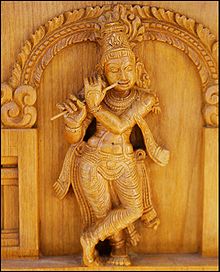 Krishna, the eighth incarnation (Avatar) of Vishnu or svayam bhagavan, worshiped across a number of traditions
Krishna, the eighth incarnation (Avatar) of Vishnu or svayam bhagavan, worshiped across a number of traditions
The Hindu scriptures refer to celestial entities called Devas (or devī in feminine form; devatā used synonymously for Deva in Hindi), "the shining ones", which may be translated into English as "gods" or "heavenly beings".[94] The devas are an integral part of Hindu culture and are depicted in art, architecture and through icons, and mythological stories about them are related in the scriptures, particularly in Indian epic poetry and the Puranas. They are, however, often distinguished from Ishvara, a supreme personal god, with many Hindus worshiping Ishvara in one of its particular manifestations (ostensibly separate deities) as their iṣṭa devatā, or chosen ideal.[95][96] The choice is a matter of individual preference,[97] and of regional and family traditions.[97]
Hindu epics and the Puranas relate several episodes of the descent of God to Earth in corporeal form to restore dharma to society and to guide humans to moksha. Such an incarnation is called an Avatar. The most prominent avatars are of Vishnu and include Rama (the protagonist in Ramayana) and Krishna (a central figure in the epic Mahabharata).
Karma and samsara
Karma translates literally as action, work, or deed,[98] and can be described as the "moral law of cause and effect".[99] According to the Upanishads an individual, known as the jiva-atma, develops sanskaras (impressions) from actions, whether physical or mental. The linga sharira, a body more subtle than the physical one but less subtle than the soul, retains impressions, carrying them over into the next life, establishing a unique trajectory for the individual.[100] Thus, the concept of a universal, neutral, and never-failing karma intrinsically relates to reincarnation as well as to one's personality, characteristics, and family. Karma binds together the notions of free will and destiny.
This cycle of action, reaction, birth, death and rebirth is a continuum called samsara. The notion of reincarnation and karma is a strong premise in Hindu thought. The Bhagavad Gita states:
“ As a person puts on new clothes and discards old and torn clothes, similarly an embodied soul enters new material bodies, leaving the old bodies.(B.G. 2:22)[101]
” Samsara provides ephemeral pleasures, which lead people to desire rebirth so as to enjoy the pleasures of a perishable body. However, escaping the world of samsara through moksha is believed to ensure lasting happiness and peace.[102][103] It is thought that after several reincarnations, an atman eventually seeks unity with the cosmic spirit (Brahman/Paramatman).
The ultimate goal of life, referred to as moksha, nirvana or samadhi, is understood in several different ways: as the realization of one's union with God; as the realization of one's eternal relationship with God; realization of the unity of all existence; perfect unselfishness and knowledge of the Self; as the attainment of perfect mental peace; and as detachment from worldly desires. Such realization liberates one from samsara and ends the cycle of rebirth.[104][105] Due to belief in the indestructibility of the soul,[106] death is deemed insignificant with respect to the cosmic self.[107] Thence, a person who has no desire or ambition left and no responsibilities remaining in life or one affected by a terminal disease may embrace death by Prayopavesa.[108]
The exact conceptualization of moksha differs among the various Hindu schools of thought. For example, Advaita Vedanta holds that after attaining moksha an atman no longer identifies itself with an individual but as identical with Brahman in all respects. The followers of Dvaita (dualistic) schools identify themselves as part of Brahman, and after attaining moksha expect to spend eternity in a loka (heaven),[109] in the company of their chosen form of Ishvara. Thus, it is said that the followers of dvaita wish to "taste sugar", while the followers of Advaita wish to "become sugar".[110]
Objectives of human life
Main article: PurusharthasClassical Hindu thought accepts the following objectives of human life, that which is sought as human purpose, aim, or end, is known as the puruṣārthas:[111][112]
- Dharma ("righteousness, ethikos")
- Artha ("livelihood, wealth")
- Kāma ("sensual pleasure")
- Mokṣa ("liberation, freedom (from samsara)")
Yoga
In whatever way a Hindu defines the goal of life, there are several methods (yogas) that sages have taught for reaching that goal. Texts dedicated to Yoga include the Bhagavad Gita, the Yoga Sutras, the Hatha Yoga Pradipika, and, as their philosophical and historical basis, the Upanishads. Paths that one can follow to achieve the spiritual goal of life (moksha, samadhi or nirvana) include:
- Bhakti Yoga (the path of love and devotion)
- Karma Yoga (the path of right action)
- Rāja Yoga (the path of meditation)
- Jñāna Yoga (the path of wisdom)[113]
An individual may prefer one or some yogas over others, according to his or her inclination and understanding. Some devotional schools teach that bhakti is the only practical path to achieve spiritual perfection for most people, based on their belief that the world is currently in the Kali Yuga (one of four epochs which are part of the Yuga cycle).[114] Practice of one yoga does not exclude others. Many schools believe that the different yogas naturally blend into and aid other yogas. For example, the practice of jnana yoga, is thought to inevitably lead to pure love (the goal of bhakti yoga), and vice versa.[115] Someone practicing deep meditation (such as in raja yoga) must embody the core principles of karma yoga, jnana yoga and bhakti yoga, whether directly or indirectly.[113][116]
Practices
Hindu practices generally involve seeking awareness of God and sometimes also seeking blessings from Devas. Therefore, Hinduism has developed numerous practices meant to help one think of divinity in the midst of everyday life. Hindus can engage in pūjā (worship or veneration),[87] either at home or at a temple. At home, Hindus often create a shrine with icons dedicated to their chosen form(s) of God. Temples are usually dedicated to a primary deity along with associated subordinate deities though some commemorate multiple deities. Visiting temples is not obligatory,[117] and many visit temples only during religious festivals. Hindus perform their worship through icons (murtis). The icon serves as a tangible link between the worshiper and God.[118] The image is often considered a manifestation of God, since God is immanent. The Padma Purana states that the mūrti is not to be thought of as mere stone or wood but as a manifest form of the Divinity.[119] A few Hindu sects, such as the Ārya Samāj, do not believe in worshiping God through icons.
Hinduism has a developed system of symbolism and iconography to represent the sacred in art, architecture, literature and worship. These symbols gain their meaning from the scriptures, mythology, or cultural traditions. The syllable Om (which represents the Parabrahman) and the Swastika sign (which symbolizes auspiciousness) have grown to represent Hinduism itself, while other markings such as tilaka identify a follower of the faith. Hinduism associates many symbols, which include the lotus, chakra and veena, with particular deities.
Mantras are invocations, praise and prayers that through their meaning, sound, and chanting style help a devotee focus the mind on holy thoughts or express devotion to God/the deities. Many devotees perform morning ablutions at the bank of a sacred river while chanting the Gayatri Mantra or Mahamrityunjaya mantras.[120] The epic Mahabharata extols Japa (ritualistic chanting) as the greatest duty in the Kali Yuga (what Hindus believe to be the current age).[121] Many adopt Japa as their primary spiritual practice.[121]
Rituals
The vast majority of Hindus engage in religious rituals on a daily basis.[122] Most Hindus observe religious rituals at home.[123] but observation of rituals greatly vary among regions, villages, and individuals. Devout Hindus perform daily chores such as worshiping at dawn after bathing (usually at a family shrine, and typically includes lighting a lamp and offering foodstuffs before the images of deities), recitation from religious scripts, singing devotional hymns, meditation, chanting mantras, reciting scriptures etc.[123] A notable feature in religious ritual is the division between purity and pollution. Religious acts presuppose some degree of impurity or defilement for the practitioner, which must be overcome or neutralised before or during ritual procedures. Purification, usually with water, is thus a typical feature of most religious action.[123] Other characteristics include a belief in the efficacy of sacrifice and concept of merit, gained through the performance of charity or good works, that will accumulate over time and reduce sufferings in the next world.[123] Vedic rites of fire-oblation (yajna) are now only occasional practices, although they are highly revered in theory. In Hindu wedding and burial ceremonies, however, the yajña and chanting of Vedic mantras are still the norm.[124] The rituals, upacharas, change with time. For instance, in the past few hundred years some rituals, such as sacred dance and music offerings in the standard Sodasa Upacharas set prescribed by the Agama Shastra, were replaced by the offerings of rice and sweets.
Occasions like birth, marriage, and death involve what are often elaborate sets of religious customs. In Hinduism, life-cycle rituals include Annaprashan (a baby's first intake of solid food), Upanayanam ("sacred thread ceremony" undergone by upper-caste children at their initiation into formal education) and Śrāddha (ritual of treating people to a meal in return for prayers to 'God' to give peace to the soul of the deceased).[125][126] For most people in India, the betrothal of the young couple and the exact date and time of the wedding are matters decided by the parents in consultation with astrologers.[125] On death, cremation is considered obligatory for all except sanyasis, hijra, and children under five.[127] Cremation is typically performed by wrapping the corpse in cloth and burning it on a pyre.
Pilgrimage
Following pilgrimage sites are most famous amongst Hindu devotees:
Char Dham (Famous Four Pilgrimage sites): The four holy sites Puri, Rameswaram, Dwarka, and Badrinath (or alternatively the Himalayan towns of Badrinath, Kedarnath, Gangotri, and Yamunotri) compose the Char Dham (four abodes) pilgrimage circuit.
Kumbh Mela: The Kumbh Mela (the "pitcher festival") is one of the holiest of Hindu pilgrimages that is held every four years; the location is rotated among Allahabad, Haridwar, Nashik, and Ujjain.
Old Holy cities as per Puranic Texts: Varanasi formerly known as Kashi, Allahabad formerly known as Prayag, Haridwar-Rishikesh, Mathura-Vrindavan, and Ayodhya.
Major Temple cities: Puri, which hosts a major Vaishnava Jagannath temple and Rath Yatra celebration; Katra, home to the Vaishno Devi temple; Three comparatively recent temples of fame and huge pilgrimage are Shirdi, home to Sai Baba of Shirdi, Tirumala - Tirupati, home to the Tirumala Venkateswara Temple; and Sabarimala,where Swami Ayyappan is worshipped.
Shakti Peethas: Another important set of pilgrimages are the Shakti Peethas, where the Mother Goddess is worshipped, the two principal ones being Kalighat and Kamakhya.
While there are different yet similar pilgrimage routes in different parts of India, all are respected equally well, according to the universality of Hinduism.
Pilgrimage is not mandatory in Hinduism, though many adherents undertake them[128]
Festivals
Main article: Hindu festivalsHindu festivals (Sanskrit: Utsava; literally: "to lift higher") are considered as symbolic rituals that beautifully weave individual and social life to dharma.[129] Hinduism has many festivals throughout the year. The Hindu calendar usually prescribe their dates.
The festivals typically celebrate events from Hindu mythology, often coinciding with seasonal changes. There are festivals which are primarily celebrated by specific sects or in certain regions of the Indian subcontinent.
Some widely observed Hindu festivals are
- Maha Shivaratri
- Pongal
- Holi
- Vasant Panchami
- Thaipusam
- Ram Navami
- Krishna Janmastami
- Ganesh Chaturthi
- Shigmo
- Dussera
- Durga Puja
- Diwali
Scriptures
Hinduism is based on "the accumulated treasury of spiritual laws discovered by different persons in different times".[130][131] The scriptures were transmitted orally in verse form to aid memorization, for many centuries before they were written down.[132] Over many centuries, sages refined the teachings and expanded the canon. In post-Vedic and current Hindu belief, most Hindu scriptures are not typically interpreted literally. More importance is attached to the ethics and metaphorical meanings derived from them.[23] Most sacred texts are in Sanskrit. The texts are classified into two classes: Shruti and Smriti.
Shruti
 The Naradeya Purana describes the mechanics of the cosmos. Depicted here are Vishnu with his consort Lakshmi resting on Shesha Nag. Narada and Brahma are also pictured.
The Naradeya Purana describes the mechanics of the cosmos. Depicted here are Vishnu with his consort Lakshmi resting on Shesha Nag. Narada and Brahma are also pictured.
Shruti (lit: that which is heard)[133] primarily refers to the Vedas, which form the earliest record of the Hindu scriptures. While many Hindus revere the Vedas as eternal truths revealed to ancient sages (Ṛṣis),[131] some devotees do not associate the creation of the Vedas with a god or person. They are thought of as the laws of the spiritual world, which would still exist even if they were not revealed to the sages.[130][134][135] Hindus believe that because the spiritual truths of the Vedas are eternal, they continue to be expressed in new ways.[136]
There are four Vedas (called Ṛg-, Sāma-, Yajus- and Atharva-). The Rigveda is the first and most important Veda.[137] Each Veda is divided into four parts: the primary one, the Veda proper, being the Saṃhitā, which contains sacred mantras. The other three parts form a three-tier ensemble of commentaries, usually in prose and are believed to be slightly later in age than the Saṃhitā. These are: the Brāhmaṇas, Āraṇyakas, and the Upanishads. The first two parts were subsequently called the Karmakāṇḍa (ritualistic portion), while the last two form the Jñānakāṇḍa (knowledge portion).[138] While the Vedas focus on rituals, the Upanishads focus on spiritual insight and philosophical teachings, and discuss Brahman and reincarnation.[23][139][140]
A well known shloka from Brihadaranyaka Upanishad is:
-
- ॐ असतो मा सद्गमय । तमसो मा ज्योतिर्गमय ।।
- मृत्योर्मामृतं गमय । ॐ शान्ति शान्ति शान्ति ।।
- ॐ असतो मा सद्गमय । तमसो मा ज्योतिर्गमय ।।
– बृहदारण्यक उपनिषद् 1.3.28.
IAST:
- om asato mā sadgamaya | tamaso mā jyotirgamaya ||
- mṛtyor mā amṛtaṁ gamaya | om śānti śānti śānti ||
– bṛhadāraṇyaka upaniṣada 1.3.28
Translation:
- Lead Us From the Unreal To the Real |
- Lead Us From Darkness To Light ||
- Lead Us From Death To Immortality |
- OM Let There Be Peace Peace Peace.||
– Brihadaranyaka Upanishad 1.3.28.
Smritis
Hindu texts other than the Shrutis are collectively called the Smritis (memory). The most notable of the smritis are the epics, which consist of the Mahābhārata and the Rāmāyaṇa. The Bhagavad Gītā is an integral part of the Mahabharata and one of the most popular sacred texts of Hinduism. It contains philosophical teachings from Krishna, an incarnation of Vishnu, told to the prince Arjuna on the eve of a great war. The Bhagavad Gītā, spoken by Krishna, is described as the essence of the Vedas.[141] However Gita, sometimes called Gitopanishad, is more often placed in the Shruti, category, being Upanishadic in content.[142] Purāṇas, which illustrate Hindu ideas through vivid narratives come under smritis. Other texts include Devī Mahātmya, the Tantras, the Yoga Sutras, Tirumantiram, Shiva Sutras and the Hindu Āgamas. A more controversial text, the Manusmriti, is a prescriptive lawbook which lays the societal codes of social stratification which later evolved into the Indian caste system.[143]
A well known verse from Bhagavad Gita describing a concept in Karma Yoga is explained as follows[144][145]
To action alone hast thou a right and never at all to its fruits;let not the fruits of action be thy motive;
neither let there be in thee any attachment to inaction. (2.47)Demographics
Part of a series on
Hinduism by countryAsiaEuropeNorth AmericaHinduism is a major religion in India and according to 2001 census, Hinduism was followed by around 80% of population in India.[146] Other significant populations are found in Nepal (23 million), Bangladesh (14 million) and the Indonesian island of Bali (3.3 million).
Countries with the greatest proportion of Hindus from Hinduism by country (as of 2008[update]):
 Nepal 86.5%[147]
Nepal 86.5%[147] India 82%
India 82% Mauritius 54%[148]
Mauritius 54%[148] Guyana 28%[149]
Guyana 28%[149] Fiji 27.9%[150]
Fiji 27.9%[150] Bhutan 25%[151]
Bhutan 25%[151] Trinidad and Tobago 22.5%
Trinidad and Tobago 22.5% Suriname 20%[152]
Suriname 20%[152] Sri Lanka 15%[153]
Sri Lanka 15%[153] Bangladesh 9%[154]
Bangladesh 9%[154] Qatar 7.2%
Qatar 7.2% Réunion 6.7%
Réunion 6.7% Malaysia 6.3%[155]
Malaysia 6.3%[155] Bahrain 6.25%
Bahrain 6.25% Kuwait 6%
Kuwait 6% United Arab Emirates 5%
United Arab Emirates 5% Singapore 4%
Singapore 4% Oman 3%
Oman 3% Belize 2.3%
Belize 2.3% Seychelles 2.1%[156]
Seychelles 2.1%[156]
Demographically, Hinduism is the world's third largest religion, after Christianity and Islam.
Society
Denominations
Hinduism has no central doctrinal authority and many practising Hindus do not claim to belong to any particular denomination.[157] However, academics categorize contemporary Hinduism into four major denominations: Vaishnavism, Shaivism, Shaktism and Smartism. The denominations differ primarily in the god worshipped as the Supreme One and in the traditions that accompany worship of that god.
Vaishnavas worship Vishnu as the supreme God; Shaivites worship Shiva as the supreme; Shaktas worship Shakti (power) personified through a female divinity or Mother Goddess, Devi; while Smartas believe in the essential oneness of five (panchadeva) or six (Shanmata, as Tamil Hindus add Skanda)[158] deities as personifications of the Supreme.
The Western conception of what Hinduism is has been defined by the Smarta view; many Hindus, who may not understand or follow Advaita philosophy, in contemporary Hinduism, invariably follow the Shanmata belief worshiping many forms of God. One commentator, noting the influence of the Smarta tradition, remarked that although many Hindus may not strictly identify themselves as Smartas but, by adhering to Advaita Vedanta as a foundation for non-sectarianism, are indirect followers.[159]
Other denominations like Ganapatya (the cult of Ganesha) and Saura (Sun worship) are not so widespread.
There are movements that are not easily placed in any of the above categories, such as Swami Dayananda Saraswati's Arya Samaj, which rejects image worship and veneration of multiple deities. It focuses on the Vedas and the Vedic fire sacrifices (yajña).
The Tantric traditions have various sects, as Banerji observes:
“ Tantras are ... also divided as āstika or Vedic and nāstika or non-Vedic. In accordance with the predominance of the deity the āstika works are again divided as Śākta (Shakta), Śaiva (Shaiva), Saura, Gāṇapatya and Vaiṣṇava (Vaishnava).[160] ” Ashramas
Main article: AshramaTraditionally the life of a Hindu is divided into four Āshramas (phases or stages; unrelated meanings include monastery). The first part of one's life, Brahmacharya, the stage as a student, is spent in celibate, controlled, sober and pure contemplation under the guidance of a Guru, building up the mind for spiritual knowledge. Grihastha is the householder's stage, in which one marries and satisfies kāma and artha in one's married and professional life respectively (see the goals of life). The moral obligations of a Hindu householder include supporting one's parents, children, guests and holy figures. Vānaprastha, the retirement stage, is gradual detachment from the material world. This may involve giving over duties to one's children, spending more time in religious practices and embarking on holy pilgrimages. Finally, in Sannyāsa, the stage of asceticism, one renounces all worldly attachments to secludedly find the Divine through detachment from worldly life and peacefully shed the body for Moksha.[161]
Monasticism
Some Hindus choose to live a monastic life (Sannyāsa) in pursuit of liberation or another form of spiritual perfection. Monastics commit themselves to a life of simplicity, celibacy, detachment from worldly pursuits, and the contemplation of God.[162] A Hindu monk is called a sanyāsī, sādhu, or swāmi. A female renunciate is called a sanyāsini. Renunciates receive high respect in Hindu society because their outward renunciation of selfishness and worldliness serves as an inspiration to householders who strive for mental renunciation. Some monastics live in monasteries, while others wander from place to place, trusting in God alone to provide for their needs.[163] It is considered a highly meritorious act for a householder to provide sādhus with food or other necessaries. Sādhus strive to treat all with respect and compassion, whether a person may be poor or rich, good or wicked, and to be indifferent to praise, blame, pleasure, and pain.[162]
Varnas
Main article: Varna in HinduismHindu society has traditionally been categorized into four classes, called Varnas (Sanskrit: "colour, form, appearance"):[87]
- the Brahmins: teachers and priests;
- the Kshatriyas: warriors, nobles, and kings;
- the Vaishyas: farmers, merchants, and businessmen; and
- the Shudras: servants and labourers.
Hindus and scholars debate whether the so-called caste system is an integral part of Hinduism sanctioned by the scriptures or an outdated social custom.[164] Among the scriptures, the Varna system is mentioned sparingly and descriptively (i.e., not prescriptive); apart from a single mention in the late Rigvedic Purusha sukta, the rigid division into varnas appears to be post-Vedic, appearing in classical texts from the Maurya period. The Bhagavad Gītā (4.13) states that the four varṇa divisions are created by God, and the Manusmṛiti categorizes the different castes.[165] However, at the same time, the Gītā says that one's varṇa is to be understood from one's personal qualities and one's work, not one's birth.[166] Some mobility and flexibility within the varnas challenge allegations of social discrimination in the caste system, as has been pointed out by several sociologists,[167][168] although some other scholars disagree.[169]
Many social reformers, including Mahatma Gandhi and B. R. Ambedkar, criticized caste discrimination.[170] The religious teacher Sri Ramakrishna (1836–1886) taught that
“ "Lovers of God do not belong to any caste . . . . A brahmin without this love is no longer a brahmin. And a pariah with the love of God is no longer a pariah. Through bhakti (devotion to God) an untouchable becomes pure and elevated."[171] ” Ahimsa, vegetarianism and other food customs
Hindus advocate the practice of ahiṃsā (non-violence) and respect for all life because divinity is believed to permeate all beings, including plants and non-human animals.[172] The term ahiṃsā appears in the Upanishads,[173] the epic Mahabharata[174] and Ahiṃsā is the first of the five Yamas (vows of self-restraint) in Patanjali's Yoga Sutras.[175] and the first principle for all member of Varnashrama Dharma (brahmin, kshatriya, vaishya and shudra) in Law of Manu (book 10, sutra 63 : Ahimsa, satya, asteya, shaucam and indrayanigraha, almost similar to main principles of jainism)[176][177].
In accordance with ahiṃsā, many Hindus embrace vegetarianism to respect higher forms of life. Estimates of the number of lacto vegetarians in India (includes adherents of all religions) vary between 20% and 42%.[178] The food habits vary with the community and region, for example some castes having fewer vegetarians and coastal populations relying on seafood.[179][180] Some avoid meat only on specific holy days. Observant Hindus who do eat meat almost always abstain from beef. The cow in Hindu society is traditionally identified as a caretaker and a maternal figure,[181] and Hindu society honours the cow as a symbol of unselfish giving.[182] Cow-slaughter is legally banned in almost all states of India.[183]
There are many Hindu groups that have continued to abide by a strict vegetarian diet in modern times. One example is the movement known as ISKCON (International Society for Krishna Consciousness), whose followers “not only abstain from meat, fish, and fowl, but also avoid certain vegetables that are thought to have negative properties, such as onion and garlic.”[184] A second example is the Swaminarayan Movement. The followers of this Hindu group also staunchly adhere to a diet that is devoid of meat, eggs, and seafood.[185]
Vegetarianism is propagated by the Yajur Veda and it is recommended for a satvic (purifying) lifestyle.[186] Thus, another reason that dietary purity is so eminent within Hinduism is because “the idea that food reflects the general qualities of nature: purity, energy, inertia” It follows, then, that a healthy diet should be one that promotes purity within an individual.[184]
Based on this reasoning, Hindus should avoid or minimize the intake of foods that do not promote purity. These foods include onion and garlic, which are regarded as rajasic (a state which is characterized by “tension and overbearing demeanor”) foods, and meat, which is regarded as tamasic (a state which is characterized by “anger, greed, and jealousy”).[187]
Some Hindus from certain sects - generally Shakta,[188] certain Shudra and Kshatriya castes[189][190] and certain Eastern Indian[191] and East Asian regions;[192] practise animal sacrifice (bali).[193] Although most Hindus, including the majority of Vaishnava and Shaivite Hindus abhor it.[194]
Conversion
Concepts of conversion, evangelization, and proselytization are absent from Hindu texts and have never played a significant role in practice, though acceptance of willing converts is becoming more common. Early in its history, in the absence of other competing religions, Hindus considered everyone they came across as Hindus and expected everyone they met to be Hindus.[195][196]
Hindus today continue to be influenced by historical ideas of acceptability of conversion. Hence, many Hindus continue to believe that Hinduism is an identity that can only be had from birth, while many others continue to believe that anyone who follows Hindu beliefs and practices is a Hindu, and many believe in some form of both theories. However, as a reaction to perceived and actual threat of evangelization, proselytization, and conversion activities of other major religions most modern Hindus are opposed to the idea of conversion from (any) one religion to (any) other per se.[197]
Hindus in Western countries generally accept and welcome willing converts, whereas in India acceptance of willing converts is becoming more common. With the rise of Hindu revivalist movements, reconversions to Hinduism have also risen.[198] Reconversions are well accepted since conversion out of Hinduism is not recognized.[199] Conversion into Hinduism through marriage is well accepted and often expected to enable the non-Hindu partner to fully participate in their spiritual, religious, and cultural roles within the larger Hindu family and society.[citation needed]
There is no formal process for converting to Hinduism, although in many traditions a ritual called dīkshā ("initiation") marks the beginning of spiritual life. A ritual called shuddhi ("purification") sometimes marks the return to spiritual life after reconversion. Most Hindu sects do not seek converts,[200][201][202][203] as they believe that the goals of spiritual life can be attained through any religion, as long as it is practiced sincerely.[200][204] However, some Hindu sects and affiliates such as Arya Samaj, Saiva Siddhanta Church, BAPS, the International Society for Krishna Consciousness, Bishnoi accept those who have a desire to follow Hinduism.
In general, Hindu view of religious freedom is not based on the freedom to proselytize, but the right to retain one's religion and not be subject to proselytization. Hindu leaders are advocating for changing the existing formulation of the freedom of religion clause in the Universal Declaration of Human Rights since it favours religions which proselytize.[205]
See also
- Hinduism
- List of Hindu temples
- List of notable Hindus
- List of related articles
- Related systems and religions
- Ayyavazhi
- Ayyavazhi and Hinduism
- Buddhism
- Buddhism and Hinduism
- Christianity and Hinduism
- Eastern philosophy
- Hellenism and Hinduism
- Hindu philosophy
- Hinduism and other religions
- Hinduism and Sikhism
- Indian religions
- Islam and Hinduism
- Hinduism in popular culture
- Hinduism in Avatar (2009 film)
- Other
- United States military chaplain symbols
Notes
- ^ This work and its description are shown in Pal, p. 125.
- ^ For a representation of this form identified as Maharakta, see Pal, p. 130.
- ^ a b Hinduism is variously defined as a "religion", "set of religious beliefs and practices", "religious tradition" etc. For a discussion on the topic, see: "Establishing the boundaries" in Gavin Flood (2003), pp. 1-17. René Guénon in his Introduction to the Study of the Hindu Doctrines (1921 ed.), Sophia Perennis, ISBN 0-900588-74-8, proposes a definition of the term "religion" and a discussion of its relevance (or lack of) to Hindu doctrines (part II, chapter 4, p. 58).
- ^ A Historical-developmental study of classical Indian philosophy of morals, Rajendra Prasad, Centre for Studies in Civilizations (Delhi, India), Concept Publishing Company, 2009, ISBN 8180695956, ISBN 9788180695957
- ^ Hinduism that is Sanatana Dharma, R. S. Nathan, Chinmaya Mission, 1989, ISBN 8175970650, ISBN 9788175970656
- ^ A conceptual-analytic study of classical Indian philosophy of morals, Rajendra Prasad, from preface of the book, Centre for Studies in Civilizations (Delhi, India), Project of History of Indian Science, Philosophy, and Culture. Sub Project: Consciousness, Science, Society, Value, and Yoga, Concept Publishing Company, 2008, ISBN 8180695441, ISBN 9788180695445
- ^ a b The Concise Oxford Dictionary of World Religions. Ed. John Bowker. Oxford University Press, 2000;
- ^ The term "Dharma" connotes much more than simply "law". It is not only the doctrine of religious and moral rights, but also the set of religious duties, social order, right conduct and virtuous things and deeds. As such Dharma is the Code of Ethics.[1] The modern use of the term can be traced to late 19th century Hindu reform movements (J. Zavos, Defending Hindu Tradition: Sanatana Dharma as a Symbol of Orthodoxy in Colonial India, Religion (Academic Press), Volume 31, Number 2, April 2001, pp. 109-123; see also R. D. Baird, "Swami Bhaktivedanta and the Encounter with Religions", Modern Indian Responses to Religious Pluralism, edited by Harold Coward, State University of New York Press, 1987); less literally also rendered "eternal way" (so Harvey, Andrew (2001), Teachings of the Hindu Mystics, Boulder: Shambhala, xiii, ISBN 1-57062-449-6). See also René Guénon, Introduction to the Study of the Hindu Doctrines (1921 ed.), Sophia Perennis, ISBN 0-900588-74-8, part III, chapter 5 "The Law of Manu", p. 146. On the meaning of the word "Dharma", see also René Guénon, Studies in Hinduism, Sophia Perennis, ISBN 0-900588-69-3, chapter 5, p. 45
- ^ Georgis, Faris (2010). Alone in Unity: Torments of an Iraqi God-Seeker in North America. p. 62. ISBN 1434909514. http://books.google.com/books?id=vFZrxLjtiI8C&pg=PA62.
- ^ Osborne 2005, p. 9
- ^ D. S. Sarma, Kenneth W. Morgan, The Religion of the Hindus, 1953
- ^ a b Merriam-Webster's Collegiate Encyclopedia, Merriam-Webster, 2000, p. 751
- ^ in the world.Laderman, Gary (2003), Religion and American Cultures: An Encyclopedia of Traditions, Diversity, and Popular Expressions, Santa Barbara, Calif: ABC-CLIO, pp. 119, ISBN 1-57607-238-X, "world's oldest living civilization and religion"
- ^ Turner, Jeffrey S. (1996), Encyclopedia of relationships across the lifespan, Westport, Conn: Greenwood Press, pp. 359, ISBN 0-313-29576-X, "It is also recognized as the oldest major religion in the world"
- ^ a b Klostermaier 1994, p. 1
- ^ The Gita Dhyanam is a traditional short poem sometimes found as a prefatory to editions of the Bhagavad Gita. Verse 4 refers to all the Upanishads as the cows, and the Gita as the milk drawn from them. (Chidbhavananda 1997, pp. 67–74)
- ^ "India", Oxford English Dictionary, second edition, 2100a.d. Oxford University Press.
- ^ http://www.sacred-texts.com/hin/rigveda/rv10075.htm
- ^ Thapar, R. 1993. Interpreting Early India. Delhi: Oxford University Press. p. 77
- ^ Thompson Platts, John, A dictionary of Urdu , classical Hindī, and English, W.H. Allen & Co., Oxford University 1884
- ^ O'Conell, Joseph T. (1973). "The Word 'Hindu' in Gauḍīya Vaiṣṇava Texts". Journal of the American Oriental Society 93 (3): pp. 340–344.
- ^ Swami Prabhupādā, A. C. Bhaktivedanta (1986), Bhagavad-gītā as it is, The Bhaktivedanta Book Trust, pp. 16, ISBN 089213268X, 9780892132683, http://books.google.com/?id=dSA3hsIq5dsC&pg=PA16&dq=Sanatana+dharma#v=onepage&q=%22neither%20beginning%20nor%20end%22&f=false
- ^ a b c Nikhilananda 1990, pp. 3–8
- ^ "Hindu History" The BBC names a bath and phallic symbols of the Harappan civilization as features of the "Prehistoric religion (3000-1000 BCE)".
- ^ T. Oberlies (Die Religion des Rgveda, Vienna 1998. p. 158) based on 'cumulative evidence' sets wide range of 1700–1100.
- ^ Brockington, JL (1984), The Sacred Thread: Hinduism in its Continuity and Diversity, Edinburgh University Press, p. 7
- ^ "Itihasas". ReligionFacts. http://www.religionfacts.com/hinduism/texts/itihasas.htm. Retrieved 1 October 2011.
- ^ Olivelle, Patrick, "The renouncer tradition", in Flood 2003, pp. 273–274
- ^ Eliot 2003
- ^ Radhakrishnan & Moore 1967, p. xviii–xxi.
- ^ a b c Basham 1999
- ^ Vijay Nath, From 'Brahmanism' to 'Hinduism': Negotiating the Myth of the Great Tradition, Social Scientist 2001, pp. 19-50.
- ^ Goel, Sita (1993), Tipu Sultan: villain or hero? : an anthology, Voice of India, p. 38, ISBN 9788185990088, http://books.google.co.in/books?ei=TYMYTPfXCse0rAf8-62tCg
- ^ Sharma, Hari (1991), The real Tipu: a brief history of Tipu Sultan, Rishi publications, p. 112, http://books.google.co.in/books?ei=TYMYTPfXCse0rAf8-62tCg
- ^ Purushottam (199?), Must India go Islamic?, P.S. Yog, http://books.google.com/?id=MLvXAAAAMAAJ&dq=tipu+hindu+malabar+4+lakh&q=%22over+4+lakh+Hindus%22
- ^ "Aurangzeb: Religious Policies". Manas Group, UCLA. http://www.sscnet.ucla.edu/southasia/History/Mughals/Aurang2.html. Retrieved 2011-06-26.
- ^ Studies in Islamic History and Civilizaion, David Ayalon, BRILL, 1986, p.271; ISBN 965264014X
- ^ "Halebidu - Temples of Karnataka". TempleNet.com. http://www.templenet.com/Karnataka/halebidu.html. Retrieved 2006-08-17.
- ^ J.T.F. Jordens, "Medieval Hindu Devotionalism" in & Basham 1999
- ^ J. P. Mallory, Douglas Q. Adams, The Oxford introduction to Proto-Indo-European and the Proto-Indo-European world, Oxford University Press, 2006; Mark W. Muesse, The Hindu Traditions: A Concise Introduction, Fortress Press, 201i, p33.
- ^ Jha, Preeti (2007-12-26). "Guinness comes to east Delhi: Akshardham world’s largest Hindu temple". ExpressIndia.com. http://www.expressindia.com/latest-news/Guinness-comes-to-east-Delhi-Akshardham-worlds-largest-Hindu-temple/254631/. Retrieved 2008-01-02.
- ^ Adherents.com, which itself references many sources; The World Almanac & Book of Facts 1998 being especially relevant.
- ^ Flood, Gavin. D. 1996. An introduction to Hinduism. 1996. P.14
- ^ J. McDaniel Hinduism, in John Corrigan, The Oxford Handbook of Religion and Emotion, (2007) Oxford University Press, 544 pages, pp. 52-53 ISBN 0195170210
- ^ a b c d Flood 2001, Defining Hinduism
- ^ Smith, W.C. (1962) The Meaning and End of Religion. San Francisco, Harper and Row. p. 65
- ^ Stietencron, Hinduism: On the Proper Use of A Deceptive Term, pp.1-22
- ^ Halbfass, (1991) Tradition and Reflection. Albany, SUNY Press. pp. 1-22
- ^ Smart, (1993) The Formation Rather than the Origin of a Tradition,in DISKUS: A Disembodied Journal of Religious Studies, vol. 1, no. 1, p. 1
- ^ Bryan S. Turner "Essays on the Sociology of Fate - Page 275"
- ^ Insoll, Timothy (2001), Archaeology and world religion, Routledge, ISBN 9780415221559, http://books.google.com/?id=QNxnYjYRuOMC&pg=PA35
- ^ Merriam-Webster's Encyclopedia of World Religions, p. 434
- ^ Vaz, P. (2001), "Coexistence of Secularism and Fundamentalism in India", Handbook of Global Social Policy (CRC Press): 124, ISBN 9780824703578, http://books.google.com/?id=opHYPSvPpWYC&pg=PA123&dq=oldest+major+tradition+Hinduism, retrieved 2008-06-26, "Hinduism is the oldest of all the major world religions."
- ^ Eastman, R. (1999), The Ways of Religion: An Introduction to the Major Traditions, Oxford University Press, USA
- ^ Joel Beversluis (2000), Sourcebook of the World's Religions: An Interfaith Guide to Religion and Spirituality (Sourcebook of the World's Religions, 3rd ed), Novato, Calif: New World Library, pp. 50, ISBN 1-57731-121-3
- ^ Weightman & Klostermaier 1994, p. 1
- ^ Bhagavad Gita, Sarvepalli Radhakrishnan: "Hinduism is not just a faith. It is the union of reason and intuition that can not be defined but is only to be experienced."
- ^ Ferro-Luzzi, (1991)The Polythetic-Prototype Approach to Hinduism in G.D. Sontheimer and H. Kulke (ed.) Hinduism Reconsidered. Delhi: Manohar. pp. 187-95
- ^ Koller, J. M. (1984), "JSTOR: Philosophy East and West, Vol. 34, No. 2 (April, 1984 ), pp. 234-236", Philosophy East and West (www.jstor.org) 34 (2): 234–236, JSTOR 1398925.
- ^ Hinduism in Britain Kim Knott, (2000) The South Asian Religious Diaspora in Britain, Canada, and a United States.
- ^ Harvey, Andrew (2001), Teachings of the Hindu Mystics, Boulder: Shambhala, xiii, ISBN 1-57062-449-6
- ^ Weightman 1998, pp. 262–264 "It is Hindu self-awareness and self-identity that affirm Hinduism to be one single religious universe, no matter how richly varied its contents, and make it a significant and potent force alongside the other religions of the world."
- ^ Olson, Carl (2007). The many colors of Hinduism: a thematic-historical introduction. Rutgers University Press. p. 9. ISBN 9780813540689. http://books.google.com/books?id=RVWKClYq4TUC&pg=PA9.
- ^ Andrews, Margaret; Boyle, Joyceen (2008). Transcultural concepts in nursing care. Lippincott Williams & Wilkins. p. 386. ISBN 9780781790376. http://books.google.com/books?id=rdEnV1HWrvgC&pg=PA386.
- ^ Dogra, R.C; Dogra, Urmila (2003). Let's know Hinduism: the oldest religion of infinite adaptability and diversity. Star Publications. p. 5. ISBN 9788176500562. http://books.google.com/books?id=mpzqP4NYyTkC&pg=PA5.
- ^ Badlani, Hiro (2008), Hinduism: Path of the Ancient Wisdom, iUniverse, p. 303, ISBN 9780595701834, http://books.google.com/?id=8NrQhyxH-GgC
- ^ Lane, Jan-Erik; Ersson, Svante (2005), Culture and politics: a comparative approach (Edition 2), Ashgate Publishing, Ltd, p. 149, ISBN 9780754645788, http://books.google.com/?id=mKtDY_iJH2QC&pg=PA149
- ^ de Lingen, John; Ramsurrun, Pahlad, An Introduction to The Hindu Faith, Sterling Publishers Pvt. Ltd, p. 2, ISBN 9788120740860, http://books.google.com/?id=tPoox9hTdYoC&pg=PA2
- ^ Murthy, BS (2003), Puppets of Faith: theory of communal strife, Bulusu Satyanarayana Murthy, p. 7, ISBN 9788190191111, http://books.google.com/?id=OBQ_wWNjpZ4C&pg=PA7
- ^ "India and Hinduism". Religion of World. ThinkQuest Library. http://library.thinkquest.org/28038/page1_3.html. Retrieved 2007-07-17.
- ^ Brodd, Jefferey (2003), World Religions, Winona, MN: Saint Mary's Press, ISBN 978-0-88489-725-5
- ^ Rogers, Peter (2009), Ultimate Truth, Book 1, AuthorHouse, p. 109, ISBN 9781438979687, http://books.google.com/?id=e3kf6GtwaT0C&pg=PA109
- ^ Chakravarti, Sitansu (1991), Hinduism, a way of life, Motilal Banarsidass Publ., p. 71, ISBN 9788120808997, http://books.google.com/?id=J_-rASTgw8wC&pg=PA71
- ^ "Polytheism". Encyclopædia Britannica. Encyclopædia Britannica Online. 2007. http://www.britannica.com/eb/article-38143/polytheism. Retrieved 2007-07-05.
- ^ Pattanaik, Devdutt (2002), The man who was a woman and other queer tales of Hindu lore, Routledge, p. 38, ISBN 9781560231813, http://books.google.com/?id=Odsk9xfOp6oC&pg=PA38
- ^ See Michaels 2004, p. xiv and Gill, N.S. "Henotheism". About, Inc. http://ancienthistory.about.com/cs/egyptmyth/g/henotheism.htm. Retrieved 2007-07-05.
- ^ Kenneth, Kramer (1986), World scriptures: an introduction to comparative religions, p. 34, ISBN 9780809127818, http://books.google.com/books?id=RzUAu-43W5oC&pg=PA34
- ^ Subodh Varma (May 6, 2011). speculation "The gods came afterwards". Times of India. http://articles.timesofindia.indiatimes.com/2011-05-06/vintage-wisdom/28377203_1_vedas-philosophy- speculation. Retrieved 2011-06-09.
- ^ a b Monier-Williams 1974, pp. 20–37
- ^ a b c & Bhaskarananda 1994
- ^ Vivekananda 1987
- ^ Werner 1994, p. p37
- ^ See Theistic Explanations of Karma, pg. 146 of Causation and Divine Intervention by BR Reichenbach, citing Uddyotakara, Nyaayavaarttika, IV, 1, 21, at http://ccbs.ntu.edu.tw/FULLTEXT/JR-PHIL/reiche2.htm
- ^ Reichenbach, Bruce R. (April 1989), "Karma, causation, and divine intervention", Philosophy East and West (Hawaii: University of Hawaii Press) 39 (2): pp. 135–149, doi:10.2307/1399374, http://ccbs.ntu.edu.tw/FULLTEXT/JR-PHIL/reiche2.htm, retrieved 2009-12-29.
- ^ Neville, Robert (2001), Religious truth, p. 47, ISBN 9780791447789, http://books.google.com/books?id=ThLR13JpCWsC
- ^ Werner 1994, p. 7
- ^ a b c d e Monier-Williams 2001
- ^ The Lord'S Song Gita, Dr.Sant K.Bhatnagar, Pustak Mahal, 2009, ISBN 812231032X, ISBN 9788122310320
- ^ Sen Gupta 1986, p. viii
- ^ Sāṁkhyapravacana Sūtra I.92.
- ^ Rajadhyaksha (1959), The six systems of Indian philosophy, p. 95, http://books.google.com/books?id=ihkRAQAAIAAJ
- ^ Neville, Robert (2001), Religious truth, p. 51, ISBN 9780791447789, http://books.google.com/books?id=ThLR13JpCWsC
- ^ Coward, Harold (2008-02), The perfectibility of human nature in eastern and western thought, p. 114, ISBN 9780791473368, http://books.google.com/books?id=LkE_8uch5P0C
- ^ For translation of deva in singular noun form as "a deity, god", and in plural form as "the gods" or "the heavenly or shining ones", see: Monier-Williams 2001, p. 492. In fact, there are different ranks among the devas. The highest are the immortal Mahadevas, such as Shiva, Vishnu, etc. The second-rank devas, such as Ganesha, are described as their offspring: they are "born", and their "lifespan" is quite limited. In ISKCON the word is translated as "demigods", although it can also denote such heavenly denizens as gandharvas. See: "Vedic cosmology". Vedic Knowledge Online. VEDA - Bhaktivedanta Book Trust. http://www.veda.harekrsna.cz/planetarium/index.htm. Retrieved 2007-06-25.. For translation of devatā as "godhead, divinity", see: Monier-Williams 2001, p. 495.
- ^ Werner 1994, p. 80
- ^ Renou 1961, p. 55
- ^ a b Harman 2004, pp. 104–106
- ^ * Apte, Vaman S (1997), The Student's English-Sanskrit Dictionary (New ed.), Delhi: Motilal Banarsidas, ISBN 8120803000
- ^ Smith 1991, p. 64
- ^ Radhakrishnan 1996, p. 254
- ^ Bhagavad Gita 2.22
- ^ See Bhagavad Gita XVI.8-20
- ^ See Vivekananda, Swami (2005), Jnana Yoga, Kessinger Publishing, ISBN 1-425482-88-0 301-02 (8th Printing 1993)
- ^ Rinehart 2004, pp. 19–21
- ^ Bhaskarananda 1994, pp. 79–86
- ^ Europa Publications Staff (2003), The Far East and Australasia, 2003 - Regional surveys of the world, Routledge, p. 39, ISBN 9781857431339, http://books.google.com/?id=e5Az1lGCJwQC&pg=PA39
- ^ Hindu spirituality - Volume 25 of Documenta missionalia, Editrice Pontificia Università Gregoriana, 1999, p. 1, ISBN 9788876528187, http://books.google.com/?id=58UZWWzqglMC
- ^ "Hinduism - Euthanasia and Suicide". BBC. 2009-08-25. http://www.bbc.co.uk/religion/religions/hinduism/hinduethics/euthanasia.shtml.
- ^ The Christian concepts of Heaven and Hell do not translate directly into Hinduism. Spiritual realms such as Vaikunta (the abode of Vishnu) or loka are the closest analogues to an eternal Kingdom of God.
- ^ Nikhilananda 1992
- ^ as discussed in Mahābhārata 12.161; Bilimoria et al. (eds.), Indian Ethics: Classical Traditions and Contemporary Challenges (2007), p. 103; see also Werner 1994, Bhaskarananda 1994, p. 7
- ^ The Philosophy of Hinduism : Four Objectives of Human Life ; Dharma (Right Conduct), Artha (iRght Wealth), Kama (Rght Desire), Moksha (Right Exit (Liberation)), Pustak Mahal, 2006, ISBN 81-223-0945-3
- ^ a b Bhaskarananda 1994
- ^ For example, see the following translation of B-Gita 11.54: "My dear Arjuna, only by undivided devotional service can I be understood as I am, standing before you, and can thus be seen directly. Only in this way can you enter into the mysteries of My understanding." (Bhaktivedanta 1997, ch. 11.54)
- ^ "One who knows that the position reached by means of analytical study can also be attained by devotional service, and who therefore sees analytical study and devotional service to be on the same level, sees things as they are." (Bhaktivedanta 1997, ch. 5.5)
- ^ Monier-Williams 1974, p. 116
- ^ Bhaskarananda 1994, p. 157
- ^ Bhaskarananda 1994, p. 137
- ^ arcye viṣṇau śīlā-dhīr. . . narakī saḥ.
- ^ Albertson, Todd (2009), The gods of business: the intersection of faith and the marketplace, p. 71, ISBN 9780615138008, http://books.google.com/?id=ipTZBagrIu0C&pg=PA71
- ^ a b Narendranand (Swami) (2008), Hindu spirituality: a help to conduct prayer meetings for Hindus, Jyoti Ashram, p. 51, http://books.google.co.in/books?ei=WwIvTNWQKsSFrAehsKDzBQ
- ^ "Religious Life". Religions of India. Global Peace Works. http://www.religionsofindia.org/loc/india_religious_life.html. Retrieved 2007-04-19.
- ^ a b c d "Domestic Worship". Country Studies. The Library of Congress. September 1995. http://lcweb2.loc.gov/cgi-bin/query/r?frd/cstdy:@field(DOCID+in0055). Retrieved 2007-04-19.
- ^ "Hindu Marriage Act, 1955". http://www.sudhirlaw.com/HMA55.htm. Retrieved 2007-06-25.
- ^ a b "Life-Cycle Rituals". Country Studies: India. The Library of Congress. September 1995. http://lcweb2.loc.gov/cgi-bin/query/r?frd/cstdy:@field(DOCID+in0056). Retrieved 2007-04-19.
- ^ Banerjee, Suresh Chandra. "Shraddha". Banglapedia. Asiatic Society of Bangladesh. http://banglapedia.search.com.bd/HT/S_0516.htm. Retrieved 2007-04-20.
- ^ Garces-Foley 30
- ^ Fuller 2004
- ^ Hindu culture, custom, and ceremony, p195, Brojendra Nath Banerjee, Agam, 1978, 26 May 2009
- ^ a b Vivekananda 1987, pp. 6–7 Vol I
- ^ a b Vivekananda 1987, pp. 118–120 Vol III
- ^ Sargeant & Chapple 1984, p. 3
- ^ See, for instance, René Guénon Man and His Becoming According to the Vedanta (1925 ed.), Sophia Perennis, ISBN 0-900588-62-4, chapter 1, "General remarks on the Vedanta, p.7.
- ^ Note: Nyaya-Vaisheshika believe that the Vedas were created by God, not eternal.
- ^ Harshananda, Swami (1989), A Bird's Eye View of the Vedas, in "Holy Scriptures: A Symposium on the Great Scriptures of the World" (2nd ed.), Mylapore: Sri Ramakrishna Math, ISBN 81-7120-121-0
- ^ Vivekananda 1987, p. 374 Vol II
- ^ Rigveda is not only the oldest among the vedas, but is one of the earliest Indo-European texts.
- ^ "Swami Shivananda's mission". http://www.dlshq.org/religions/vedas.htm. Retrieved 2007-06-25.
- ^ Werner 1994, p. 166
- ^ Monier-Williams 1974, pp. 25–41
- ^ Sarvopaniṣado gāvo, etc. (Gītā Māhātmya 6). Gītā Dhyānam, cited in Introduction to Bhagavad-gītā As It Is.
- ^ Thomas B. Coburn, Scripture" in India: Towards a Typology of the Word in Hindu Life, Journal of the American Academy of Religion, Vol. 52, No. 3 (September, 1984), pp. 435-459
- ^ Sawant, Ankush (1996), Manu-smriti and Republic of Plato: a comparative and critical study, Himalaya Pub. House, http://books.google.com/?id=WnLaAAAAMAAJ
- ^ Radhakrishnan 1993, p. 119
- ^ The Bhagavad Gita, Eknath Easwaran, Edition 2, Nilgiri Press, 2007, ISBN 1586380192, ISBN 9781586380199
- ^ CIA-The world factbook
- ^ http://www.state.gov/g/drl/rls/irf/2009/127369.htm
- ^ Dostert, Pierre Etienne. Africa 1997 (The World Today Series). Harpers Ferry, West Virginia: Stryker-Post Publications (1997), pg. 162.
- ^ https://www.cia.gov/library/publications/the-world-factbook/geos/gy.html
- ^ https://www.cia.gov/library/publications/the-world-factbook/geos/fj.html
- ^ http://www.state.gov/g/drl/rls/irf/2009/127364.htm
- ^ http://www.state.gov/g/drl/rls/irf/2009/127405.htm
- ^ http://www.srilankantourism.com/religious-tours/hindu-religious.html
- ^ http://www.state.gov/g/drl/rls/irf/2009/127363.htm
- ^ https://www.cia.gov/library/publications/the-world-factbook/geos/my.html
- ^ https://www.cia.gov/library/publications/the-world-factbook/geos/se.html
- ^ Werner 1994, p. 73
- ^ http://www.mailerindia.com/god/hindu/index.php?skanda
- ^ Heart of Hinduism: The Smarta Tradition
- ^ Banerji 1992, p. 2
- ^ S.S. Rama Rao Pappu, "Hindu Ethics", in Rinehart 2004, pp. 165–168
- ^ a b Bhaskarananda 1994, p. 112
- ^ Michaels 2004, p. 316
- ^ Michaels 2004, pp. 188–197
- ^ Manu Smriti Laws of Manu 1.87-1.91
- ^ This view is supported by records of sages who became Brahmins. For example, the sage Vishvāmitra was a king of the Kṣhatriya caste, and only later became recognized as a great Brahmin sage, indicating that his caste was not determined by birth. Similarly, Vālmiki, once a low-caste robber, became a sage.
- ^ Silverberg 1969, pp. 442–443
- ^ Smelser & Lipset 2005
- ^ Smith, Huston (1994). "Hinduism: The Stations of Life". New York, New York, USA: HarperCollins. ISBN 0-06-067440-7.
- ^ Elenanor Zelliot, "Caste in Contemporary India", in Rinehart 2004
- ^ Nikhilananda 1992, p. 155
- ^ Monier-Williams, Religious Thought and Life in India (New Delhi, 1974 edition)
- ^ Radhakrishnan, S (1929), Indian Philosophy, Volume 1, Muirhead library of philosophy (2nd ed.), London: George Allen and Unwin Ltd., pp. 148
- ^ For ahiṃsā as one of the "emerging ethical and religious issues" in the Mahābhārata see: Brockington, John, "The Sanskrit Epics", in Flood (2003), p. 125.
- ^ For text of Y.S. 2.29 and translation of yama as "vow of self-restraint", see: Taimni, I. K. (1961), The Science of Yoga, Adyar, India: The Theosophical Publishing House, ISBN 81-7059-212-7, p. 206.
- ^ http://wikisource.org/wiki/%E0%A4%AE%E0%A4%A8%E0%A5%81%E0%A4%B8%E0%A5%8D%E0%A4%AE%E0%A5%83%E0%A4%A4%E0%A4%BF_10 अहिंसा सत्यमस्तेयं शौचमिन्द्रियनिग्रहः। एतं सामासिकं धर्मं चातुर्वर्ण्येऽब्रवीन् मनु, ahimsâ satyamstenam shaucmindrayanigrahah, etam sâmâsikam dharmam câturvanaryabravîn manu
- ^ http://www.sacred-texts.com/hin/manu/manu10.htm
- ^ Surveys studying food habits of Indians include: "Diary and poultry sector growth in India", "Indian consumer patterns" and "Agri reform in India". Results indicate that Indians who eat meat do so infrequently with less than 30% consuming non-vegetarian foods regularly, although the reasons may be economical.
- ^ Fox, Michael Allen (1999), Deep Vegetarianism, Temple University Press, ISBN 1-566397-05-7
- ^ Yadav, Y.; Kumar, S (August 14, 2006). "The food habits of a nation". The Hindu. http://www.hindu.com/2006/08/14/stories/2006081403771200.htm. Retrieved 2006-11-17.
- ^ Walker 1968:257
- ^ Richman 1988:272
- ^ Krishnakumar, R. (August 30-September 12, 2003). "Beef without borders". Frontline (Narasimhan Ram). http://www.hinduonnet.com/fline/fl2018/stories/20030912004703100.htm. Retrieved 2006-10-07.
- ^ a b Narayanan, Vasudha. “The Hindu Tradition”. In A Concise Introduction to World Religions, ed. Willard G. Oxtoby and Alan F. Segal. New York: Oxford University Press, 2007
- ^ Williams, Raymond. An Introduction to Swaminarayan Hinduism. 1st. Cambridge: Cambridge University Press, 2001. 159
- ^ Michael Keene (2002), Religion in Life and Society, Folens Limited, p. 122, ISBN 9781843032953, http://books.google.com/?id=I4AVbUIIygQC&pg=PA122, retrieved May 18, 2009
- ^ Rosen, Steven. Essential Hinduism. 1st. Westport: Praeger Publishers, 2006. Page 188
- ^ Harold F., Smith (1 Jan 2007), "12", Outline of Hinduism, Read Books, ISBN 1406789445
- ^ Smith, David Whitten; Burr, Elizabeth Geraldine (28 Dec 2007), "One", Understanding world religions: a road map for justice and peace, Rowman & Littlefield, p. 12, ISBN 0742550559
- ^ Kamphorst Janet (5 Jun 2008), "9", In praise of death: history and poetry in medieval Marwar (South Asia), Leiden University Press, p. 287, ISBN 9087280440
- ^ Fuller Christopher John (2004), "4", The camphor flame: popular Hinduism and society in India (Revised and Expanded ed.), Princeton University Press, p. 83, ISBN 978-0-691-12048-5, http://press.princeton.edu/titles/7823.html
- ^ Gouyon Anne; Bumi Kita Yayasan (30 Sep 2005), "The Hiden Life of Bali", The natural guide to Bali: enjoy nature, meet the people, make a difference, Equinox Publishing (Asia) Pte Ltd, p. 51, ISBN 9793780002, http://bookshop.blackwell.co.uk/jsp/welcome.jsp?action=search&type=isbn&term=9793780002, retrieved 12 August 2010
- ^ Fuller C. J. (26 July 2004), "4 Sacrifice", The Camphor Flame: Popular Hinduism and Society in India [Paperback] (Revised ed.), Princeton University Press, p. 83, ISBN 069112048X
- ^ "Religious or Secular: Animal Slaughter a Shame" (in English). The Hindu American foundation. 2009.
- ^ Geoffray, Davis; Peter Marsden, Benedicte Ledent, Marc Delrez (2005), Towards a Transcultural Future: Literature and society in a post-colonial world, Rodopi, pp. 106, ISBN 9042017368, http://books.google.com/?id=_0QNztm0EHYC&pg=PA106
- ^ Ketkar, Shridhar (1909), The History of Caste in India, Taylor & Carpenter, pp. 87–89, http://books.google.com/?id=_c9OAAAAMAAJ&pg=PA89
- ^ Omar, Rashid (August 2006) (PDF), The Right to Religious Conversion: Between Apostasy and Proselytization, Kroc Institute, University of Notre Dame, pp. 3, http://kroc.nd.edu/ocpapers/op_27_1.pdf
- ^ Reuter, Thomas (September 2004), Java's Hinduism Revivial, Hinduism Today, http://www.hinduismtoday.com/archives/2004/10-12/52-53_revivial.shtml
- ^ Tamil Nadu: Dalit Christians embrace Hinduism Indian Express - August 10, 2009
- ^ a b Catharine Cookson (2003), Encyclopedia of religious freedom, Taylor & Francis, p. 180, ISBN 9780415941815, http://books.google.com/?id=R0PrjC1Ar7gC&pg=PA180&dq=seek
- ^ J. N. Nanda (1991), Conflicts and co-existence, India, Concept Publishing Company, p. 93, ISBN 9788170223023, http://books.google.com/?id=U-vX_LbZOVkC&pg=PA93&dq=seek
- ^ William Stoddart (1993), Outline of Hinduism, Foundation for Traditional Studies, p. 13, ISBN 9780962998416, http://books.google.com/?id=wjR9AAAAMAAJ&q=seek
- ^ Jeffery D. Long (2007), A vision for Hinduism: beyond Hindu nationalism, I.B.Tauris, p. 188, ISBN 9781845112738, http://books.google.com/?id=frXUGoWuK4wC&pg=PA188&dq=seek
- ^ See Swami Bhaskarananda, Essentials of Hinduism pp. 189-92 (Viveka Press 1994) ISBN 1-884852-02-5
- ^ Omar, Rashid (August 2006) (PDF), The Right to Religious Conversion: Between Apostasy and Proselytization, Kroc Institute, University of Notre Dame, pp. 4, http://kroc.nd.edu/ocpapers/op_27_1.pdf
References
- Banerji, S. C. (1992), Tantra in Bengal (Second Revised and Enlarged ed.), Delhi: Manohar, ISBN 81-85425-63-9
- Basham, A.L (1999), A Cultural History of India, Oxford University Press, ISBN 0-19-563921-9
- Bhaktivedanta, A. C. (1997), Bhagavad-Gita As It Is, Bhaktivedanta Book Trust, ISBN 089213285X, http://bhagavadgitaasitis.com/, retrieved 2007-07-14
- Bhaskarananda, Swami (1994), The Essentials of Hinduism: a comprehensive overview of the world's oldest religion, Seattle, WA: Viveka Press, ISBN 1-884852-02-5[unreliable source?]
- Bhattacharyya, N.N (1999), History of the Tantric Religion (Second Revised ed.), Delhi: Manohar Publications, ISBN 81-7304-025-7
- Chidbhavananda, Swami (1997), The Bhagavad Gita, Sri Ramakrishna Tapovanam
- Eliot, Sir Charles (2003), Hinduism and Buddhism: An Historical Sketch, I (Reprint ed.), Munshiram Manoharlal, ISBN 8121510937
- Fuller, C. J. (2004), The Camphor Flame: Popular Hinduism and Society in India, Princeton, NJ: Princeton University Press, ISBN 9780691120485
- Growse, Frederic Salmon (1996), Mathura - A District Memoir (Reprint ed.), Asian Educational Services
- Garces-Foley, Katherine (2005), Death and religion in a changing world, M. E. Sharpe
- Guénon, René (1921), Introduction to the Study of the Hindu Doctrines (1921 ed.), Sophia Perennis, ISBN 0-900588-74-8
- Guénon, René, Studies in Hinduism (1966 ed.), Sophia Perennis, ISBN 0-900588-69-3
- Guénon, René, Man and His Becoming According to the Vedanta (1925 ed.), Sophia Perennis, ISBN 0-900588-62-4
- Hoiberg, Dale (2001), Students' Britannica India, Popular Prakashan, ISBN 0852297602
- Kuruvachira, Jose (2006), Hindu nationalists of modern India, Rawat Publications, ISBN 8170339952
- Monier-Williams, Monier (2001), English Sanskrit dictionary, Delhi: Motilal Banarsidass, ISBN 8120615093, http://www.ibiblio.org/sripedia/ebooks/mw/index.html, retrieved 2007-07-24
- Morgan, Kenneth W.; Sarma, D. S. (1953), The Religion of the Hindus, Ronald Press
- Nikhilananda, Swami (1990), The Upanishads: Katha, Iśa, Kena, and Mundaka, I (5th ed.), New York: Ramakrishna-Vivekananda Center, ISBN 0-911206-15-9
- Nikhilananda, Swami (trans.) (1992), The Gospel of Sri Ramakrishna (8th ed.), New York: Ramakrishna-Vivekananda Center, ISBN 0-911206-01-9
- Oberlies, T (1999), Die Religion des Rgveda, Vienna: Institut für Indologie der Universität Wien, ISBN 3900271321
- Osborne, E (2005), Accessing R.E. Founders & Leaders, Buddhism, Hinduism and Sikhism Teacher's Book Mainstream, Folens Limited
- Radhakrishnan, S; Moore, CA (1967), A Sourcebook in Indian Philosophy, Princeton University Press, ISBN 0-691-01958-4
- Radhakrishnan, S (Trans.) (1995), Bhagvada Gita, Harper Collins, ISBN 1-855384-57-4
- Radhakrishnan, S (1996), Indian Philosophy, 1, Oxford University Press, ISBN 0195638204
- Richman, Paula (1988), Women, branch stories, and religious rhetoric in a Tamil Buddhist text, Buffalo, NY: Maxwell School of Citizenship and Public Affairs, Syracuse University, ISBN 0915984903
- Sargeant, Winthrop; Chapple, Christopher (1984), The Bhagavad Gita, New York: State University of New York Press, ISBN 0-87395-831-4
- Sen Gupta, Anima (1986), The Evolution of the Sāṃkhya School of Thought, South Asia Books, ISBN 8121500192
- Silverberg, James (1969), "Social Mobility in the Caste System in India: An Interdisciplinary Symposium", The American Journal of Sociology 75 (3): 442–443, doi:10.1086/224812
- Smelser, N.; Lipset, S., eds. (2005), Social Structure and Mobility in Economic Development, Aldine Transaction, ISBN 0202307999
- Smith, Huston (1991), The World's Religions: Our Great Wisdom Traditions, San Francisco: HarperSanFrancisco, ISBN 0062507990
- Vasu, Srisa Chandra (1919), The Catechism Of Hindu Dharma, New York: Kessinger Publishing, LLC
- Vivekananda, Swami (1987), Complete Works of Swami Vivekananda, Calcutta: Advaita Ashrama, ISBN 81-85301-75-1
- Walker, Benjamin (1968), The Hindu world: an encyclopedic survey of Hinduism, Praeger
Further reading
- Dowson, John (1888), A Classical Dictionary of Hindu Mythology and Religion, Geography, History, and Literature, Trubner & Co., London, http://www.archive.org/stream/aclassicaldictio00dowsuoft#page/n27/mode/2up
- Bowes, Pratima (1976), The Hindu Religious Tradition: A Philosophical Approach, Allied Pub, ISBN 0710086687
- Flood, Gavin (Ed) (2003), Blackwell companion to Hinduism, Blackwell Publishing, ISBN 0-631-21535-2
- Jones, Constance; Ryan, James D. (2007), Encyclopedia of Hinduism, New York, USA: Infobase Publishing, ISBN 0816054584, http://books.google.nl/books?id=hZET2sSUVsgC
- Klostermaier, K (1994), A Survey of Hinduism (3rd (2007) ed.), State University of New York Press, ISBN 0791470822, http://www.oneworld-publications.com/books/texts/hinduism-a-short-history-ch1.htm
- Lipner, Julius (1998), Hindus: Their Religious Beliefs and Practices, Routledge, ISBN 0415051819, http://www.google.co.in/books?id=HDMLYkIOoWYC&printsec=frontcover&dq=sindhu+hindu&as_brr=3, retrieved 2007-07-12
- Michaels, A (2004), Hinduism: Past and Present (5th ed.), Princeton University Press, ISBN 0-691-08953-1, http://books.google.com/books?id=PD-flQMc1ocC
- Monier-Williams, Monier (1974), Brahmanism and Hinduism: Or, Religious Thought and Life in India, as Based on the Veda and Other Sacred Books of the Hindus, Elibron Classics, Adamant Media Corporation, ISBN 1421265311, http://books.google.com/?id=U5IBXA4UpT0C&dq=isbn:1421265311, retrieved 2007-07-08
- Morgan, Kenneth W., ed. (1987), The Religion of the Hindus (New ed.), Delhi: Motilal Banarsidas, ISBN 8120803876
- Renou, Louis (1964), The Nature of Hinduism, Walker
- Rinehart, R (Ed.) (2004), Contemporary Hinduism: Ritual, Culture, and Practice, ABC-Clio, ISBN 1-57607-905-8
- Weightman, Simon (1998), "Hinduism", in Hinnells, John (Ed.), The new Penguin handbook of living religions, Penguin books, ISBN 0-140-51480-5
- Werner, Karel (1994), "Hinduism", in Hinnells, John (Ed.), A Popular Dictionary of Hinduism, Richmond, Surrey: Curzon Press, ISBN 0-7007-0279-2
External links
- Hinduism Resources for scholars on Academic Room
- Resources for Scholars and Students
- All About Hinduism by Swami Sivananda (pdf)
- Heart of Hinduism: An overview of Hindu traditions
- Information on Hinduism or Santana dharma
- Ethical Democracy Journal - Notes on Hinduism
- Religious Tolerance page on Hinduism
- Audio'
- Paper on Hinduism by Swami Vivekananda - Presented at World Parliament of Religion in 1893 (Text + Audio Version)
- Oxford Centre for Hindu Studies Lectures and seminars in MP3 audio format by the OCHS as reference material for scholars and students.
Hinduism topics
Outline · Portal · Category · Glossary Deities Philosophy SchoolsAstika
Nastika (Charvaka)
Samkhya · Yoga
Nyaya · Vaisheshika
Purva mimamsa
Uttara mimamsa (Vedanta) (Dvaita, Advaita, Vishishtadvaita)Scriptures VedangasRig vedic (Aitareya)
Atharva vedic (Mundaka · Mandukya · Prashna)
Yajur vedic (Brihadaranyaka · Isha · Taittiriya · Katha · Shvetashvatara)
Sama vedic (Chandogya · Kena)ItihasasBhagavat Gita
others
Dharma Shastra · Manusmriti
Artha Shastra · Yoga Vasistha
Sutras · Stotras · Tantras
Yoga SutraClassificationPractices WorshipGarbhadhana · Pumsavana · Simantonayana · Jatakarma · Namakarana · Nishkramana · Annaprashana · Chudakarana · Karnavedha · Vidyarambha · Upanayana · Praishartha · Keshanta · Ritushuddhi · Samavartana · Vivaha · AntyeshtiVarnashrama DharmaVarna
Ashrama(Brahmacharya · Grihastha · Vanaprastha · Sanyasa)
Brahmin · Kshatriya
Vaishya · ShudraFestivalsNavaratri
Vijayadashami (Dasara) · Deepavali · Shivaratri · Holi · Kumbha Mela · Ratha Yatra · Vishu · Bihu · Baisakhi · Puthandu · Ganesh Chaturthi · Onam · Rama Navami · Janmashtami · Raksha BandhanOther Topics Category · Portal
Mohandas Karamchand Gandhi Family Influences Ahimsa · Ashram · Bhagavad Gita · Henry David Thoreau · Civil disobedience · Fasting · Hinduism · Jainism · John Ruskin · Leo Tolstoy · The Kingdom of God Is Within You · The Masque of Anarchy · Pacifism · Sermon on the Mount · Shrimad Rajchandra · Unto This Last · VegetarianismLife Philosophy Associates Vinoba Bhave · Vallabhbhai Patel · Mirabehn · C. F. Andrews · Narhari Parikh · Ravi Shankar Vyas · Mohanlal Pandya · Mahadev Desai · Abbas Tyabji · Khan Abdul Ghaffar Khan · Dada Dharmadhikari · J. C. Kumarappa · Hermann KallenbachLegacy Influenced Martin Luther King, Jr. · James Lawson · James Bevel · Nelson Mandela · Steve Biko · Aung San Suu Kyi · Maria Lacerda de Moura · Lanza del VastoMemorials at Kanyakumari · Martin Luther King, Jr., National Historic Site · Pietermaritzburg · Rajghat · National Gandhi Museum · Gandhi SmritiMemorial observances  CategoryCategories:
CategoryCategories:
Wikimedia Foundation. 2010.



